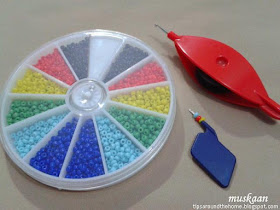vintage edging revisited
My 'homework' while the Online class is on summer break was to send in tatted models and diagrams for 7 vintage edgings from Needleart 1921. All (old & new) are indexed in Bellaonline Tatting Newsletter July 14,2017.
My 'homework' while the Online class is on summer break was to send in tatted models and diagrams for 7 vintage edgings from Needleart 1921. All (old & new) are indexed in Bellaonline Tatting Newsletter July 14,2017.
So while Georgia
I won't be following the order but stay tuned ‘coz there
are some interesting outcomes as each pattern caught my fancy differently !
Edging #7
Needleart 1921 (vol 8 issue 3)
I like to study a pattern a bit (usually the image or diagram) before starting out. If that row/round has more chains &/or thrown rings, or large rings, then I prefer working it frontside.
The same principle was followed here. Started Row I with
backside red rings and the blue chains along with the large thrown ring were
done frontside. This also enabled me to work the rest of the rows all frontside, since they are only chains & thrown rings.
Unfortunately, that vintage pic was taken at a place which
has a mistake! Took me a long time of peering closely and studying intently
(going back and forth between image, diagram, and text) to figure out and
dispel all confusion.
In my first sampler above I worked each row separately in an ombre arrangement. But the 3 separate rows can easily be worked continuously without cutting off thread.
In order to work all 3 rows in one pass, the sequence of rows has to be changed from that of original. Other minor details and corrections have been included in the new standalone pdf, with corrected pattern and new models & diagram. I have tried to follow the style & format laid out in the article.
In this second sampler,in Row I, I added 1ds to the chain on either side on the
thrown ring to give it more curvature, as can be seen when the 2 samplers are
compared.
Also, in order to the blue header, I used a Reverse Join between Rows II & III. However, the same can be effected by doing a lock join, then switching shuttles.
Also, in order to the blue header, I used a Reverse Join between Rows II & III. However, the same can be effected by doing a lock join, then switching shuttles.
I hope to convert this edging into a necklace. Wish me
luck and stress-free beadwork.
And there are lots more patterns to be shared - both vintage and the quatrefoil series :-)
And there are lots more patterns to be shared - both vintage and the quatrefoil series :-)
happy tatting always :-)))













































